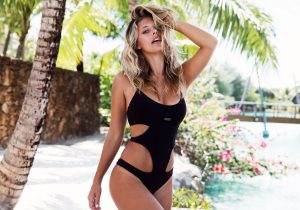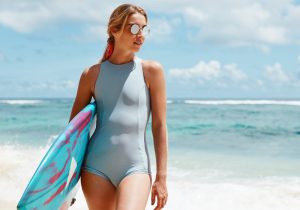When it comes to swimsuits, the fabric is not just a canvas for colorful prints and flashy colors-it's the ground upon which comfort, performance, and endurance are built. From the carefree beach bum to the competitive swimmer, from the poolside lounge to the serious athlete, the proper fabric can either make or ruin your swim. In this blog, we'll explore the most prevalent swimsuit fabric, balancing comfort with endurance, and assist you in determining which fabric is best suited to your requirements.
Why Is Swimwear Fabric Important? 
Swimwear has to contend with special challenges: chlorine, salt water, sun exposure, and continuous movement. The perfect fabric needs to balance stretch, breathability, drying quickly, and resisting fading or sagging. Making the right choice makes your swimsuit feel great, look amazing, and last longer.
The Main Contenders: Swimwear Fabrics Explained
Let's analyze the most popular materials used in swimwear, examining their strengths and weaknesses when it comes to comfort and durability.
Nylon (Polyamide): The Comfort Champion
What is it?
Nylon or polyamide is a man-made fabric that everyone loves for its silky, gentle feel and lightweight quality. It's the timeless favorite of most swim brands and is usually paired with spandex for extra stretch.
Comfort:
Very soft and silky on the skin
Lightweight and airy
Quicks-drying for comfort after swimming
Has a close-fitting, body-hugging look because of its natural stretch
Durability:
Less chlorinated than polyester
It may become less elastic or fade with frequent pool use
Excellent for resort, fashion, or beach swimwear, but not best for frequent pool use
Best suited for:
Fashion swimwear, bikinis, and one-piece suits for sunbathing or light swimming
Individuals who value comfort and fit above long-endurance durability
Polyester: The Workhorse of Durability 
What is it?
Another synthetic workhorse in swimwear, polyester is valued for its ruggedness and ability to withstand abusive pool chemicals and sun.
Comfort:
Smooth and slippery, but generally less soft than nylon
Dries rapidly but occasionally holds onto more water than nylon
Tends to be slightly stiffer, particularly in all-polyester suits.
Durability:
Excellent chlorine and UV protection-won't fade or degrade rapidly
Doesn't lose shape or color even after numerous uses and laundering
Suitable for repeat swimmers and competitive athletes
Best for:
Training, lap swimming, and anyone spending a lot of time in chlorinated pools
Those seeking a season-after-season enduring suit
Spandex (Lycra/Elastane): The Stretch Specialist
What is it? 
Spandex (also known as Lycra or elastane) is seldom used separately but is normally combined with nylon or polyester to offer the stretch and recovery properties necessary for swimsuits.
Comfort:
Provides excellent elasticity and flexibility
Adjusts with you, providing freedom of movement
Provides a firm, supportive fit that is complimentary to all body types
Durability
On its own, not very durable-susceptible to losing stretch if not maintained
When blended, allows suits to keep their shape over time
Sensitive to chlorine, so best utilized in blends with polyester for longevity
Best for:
All swimwear styles-look for blends with at least 10-20% spandex for optimal fit and comfort
Blends: The Best of Both Worlds
Most contemporary swimwear employs blends, often nylon-spandex or polyester-spandex, to achieve maximum comfort and durability.
Nylon-Spandex Blends
Soft, flexible, and snug
Fast drying and light
Less resistant to chlorine, hence more suitable for fashion or swimwear.
Polyester-Spandex Mixtures
Outstanding chlorine and UV resistance
Strong, excellent shape retention
A bit more rigid, yet ideal for athletic and competitive swimsuits.
Polyamide and Other Synthetic Materials 
Polyamide is practically another term for nylon, although certain premium labels utilize particular polyamide mixes to enhance softness, moisture-evaporation, and wear resistance.
Environmentally Friendly Substitutes
Sustainability matters more and more. Materials such as ECONYL (recycled nylon) and Repreve (recycled polyester) have the same performance as their conventional equivalents but with a reduced environmental impact.
Comfort vs. Durability: Which Do You Want?
Comfort: What Is Most Important?
Softness: Nylon-spandex blends are the benchmark for a soft, almost-not-there sensation.
Stretch: Spandex level (10-20%) means the suit stretches with you and retains its shape.
Breathability: Nylon breathes more and dries quicker, staying cool and comfortable.
Fit: 4-way stretch fabrics are best for a close-fitting, supportive feel.
Durability: What's Most Important?
Chlorine Resistance: Polyester blends and polyester spandex are best for long pool life.
UV Resistance: Polyester is resistant to fading and sun breakdown.
Shape Retention: Spandex assists, but polyester blends retain their shape best with time.
Colorfastness: Polyester and nylon are both capable of retaining bright colors, but polyester fades less.
Best Sites to Buy Swimwear from:
Athleta
Speedo
SwimOutlet
Target
These are specific brands that may have the best collection in Swimwear & Accessories but there are two of them that are our personal favorites and they are Athleta & Target. These are our favorites and the rest of the decision depends on you which brand you wanna go with.
Care Instructions to Optimize Both Comfort and Strength 
Wash swimwear in cold water after each use to get rid of chlorine and salt.
Don't wring out your suit, which can cause damage to fibers.
Dry flat in the shade; don't use direct sunlight and dryers.
Don't follow care instructions. In some cases, suits require even more careful handling.
Conclusion:
There's no one “best” swimsuit material. Perfect selection is determined by the way you swim, where you swim, and what's most important to you. For maximum comfort and style, a nylon-spandex mix can't be beat. For extreme pool users or sports athletes, polyester-spandex blends are unparalleled in their resistance and durability against chlorine and the sun.
For the best of both worlds, seek out blends that mix the stretch and softness of spandex and nylon with the durability of polyester. And if you're concerned about the earth, there are now eco-friendly solutions that provide high performance without sacrificing anything. At the end of the day, the ideal swimwear fabric is one that makes you feel good enough to dive in season after season.
Buy Now
